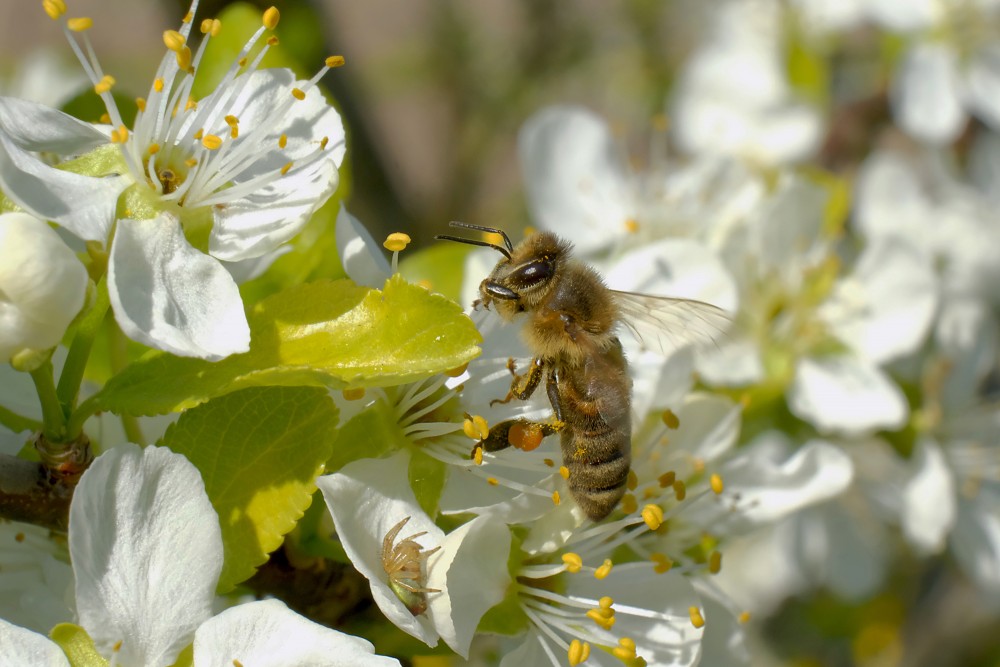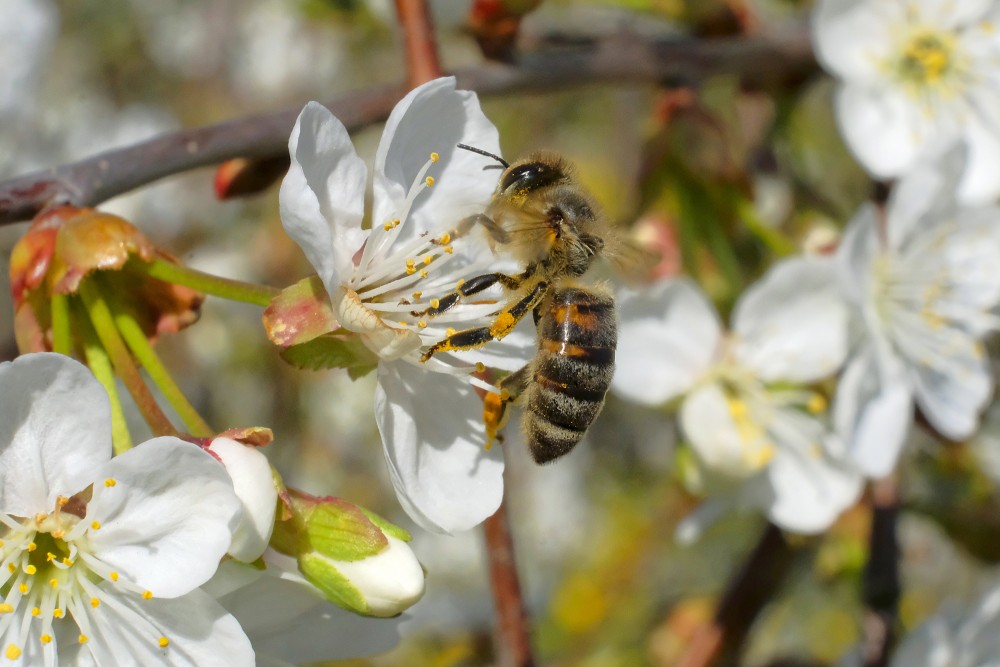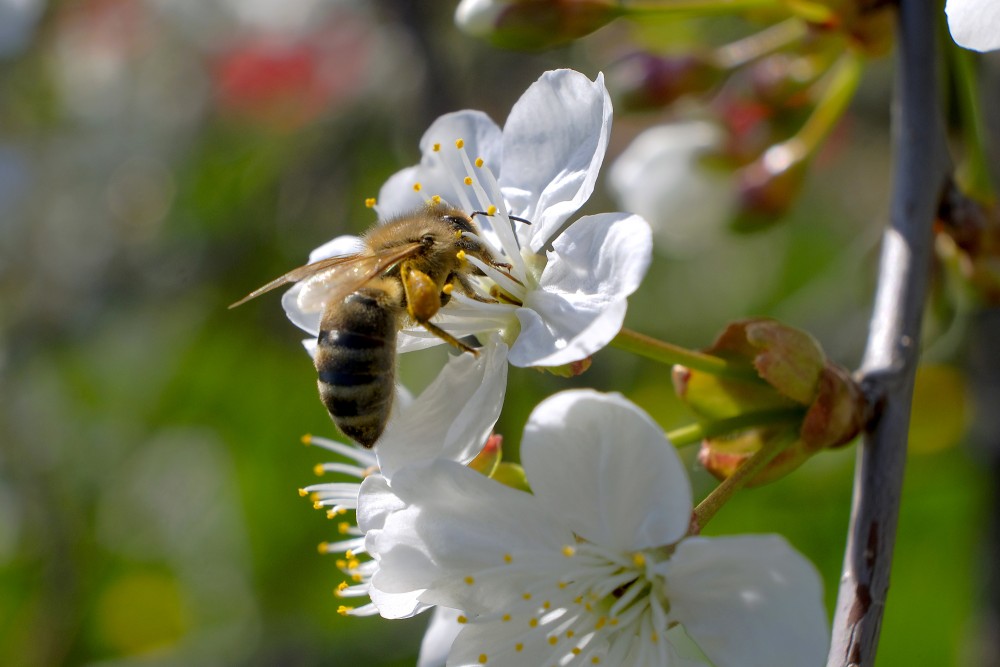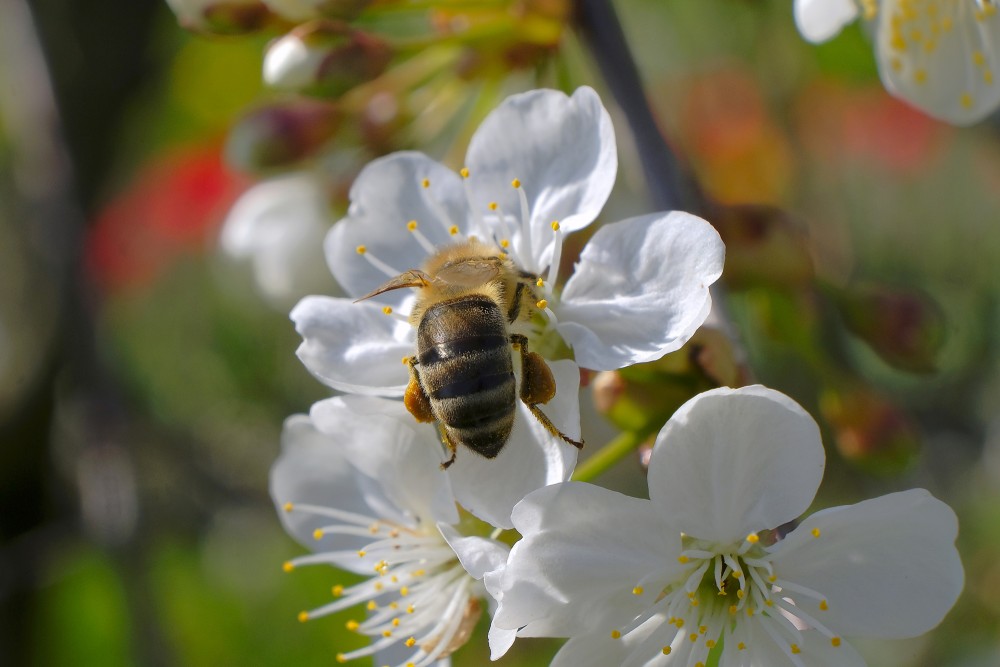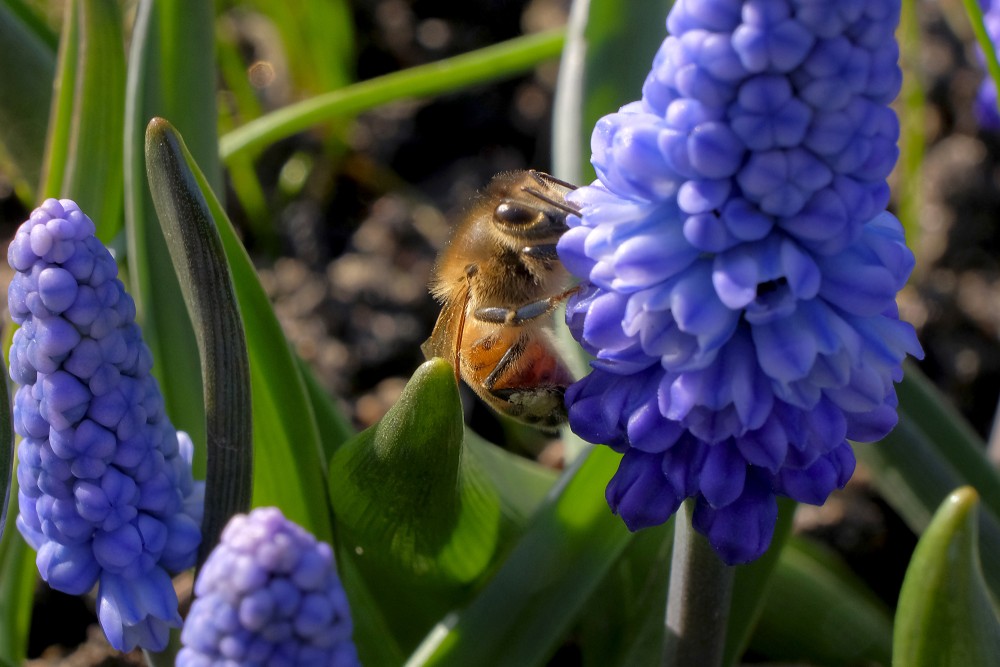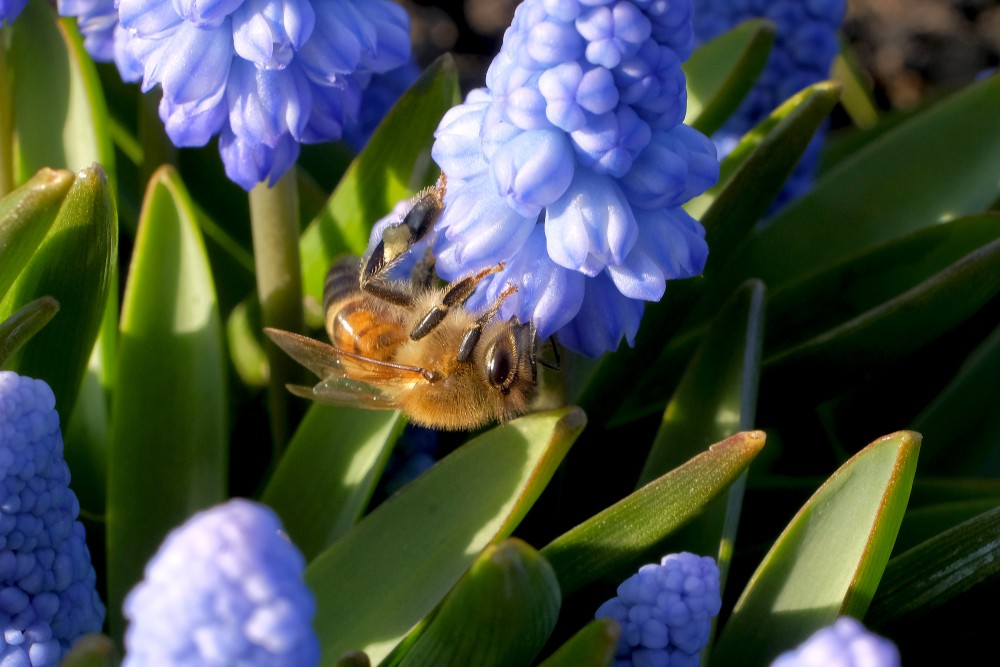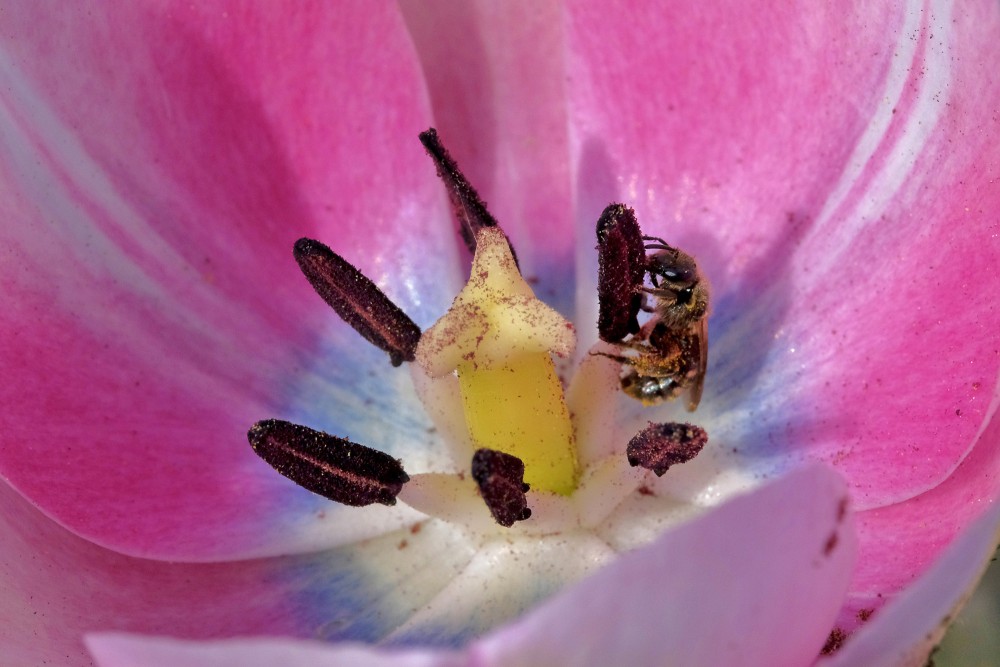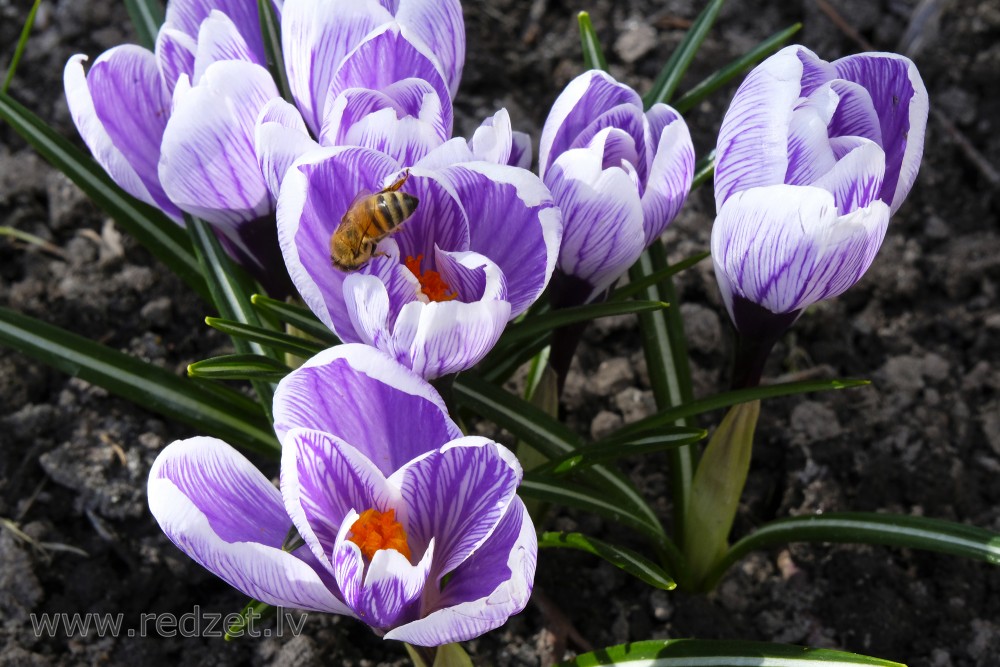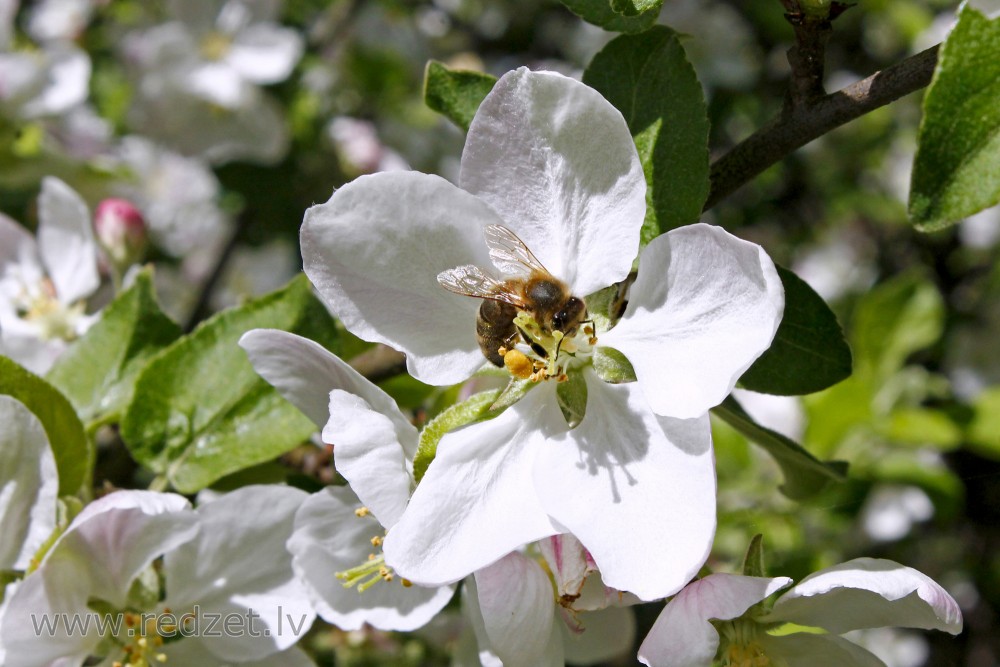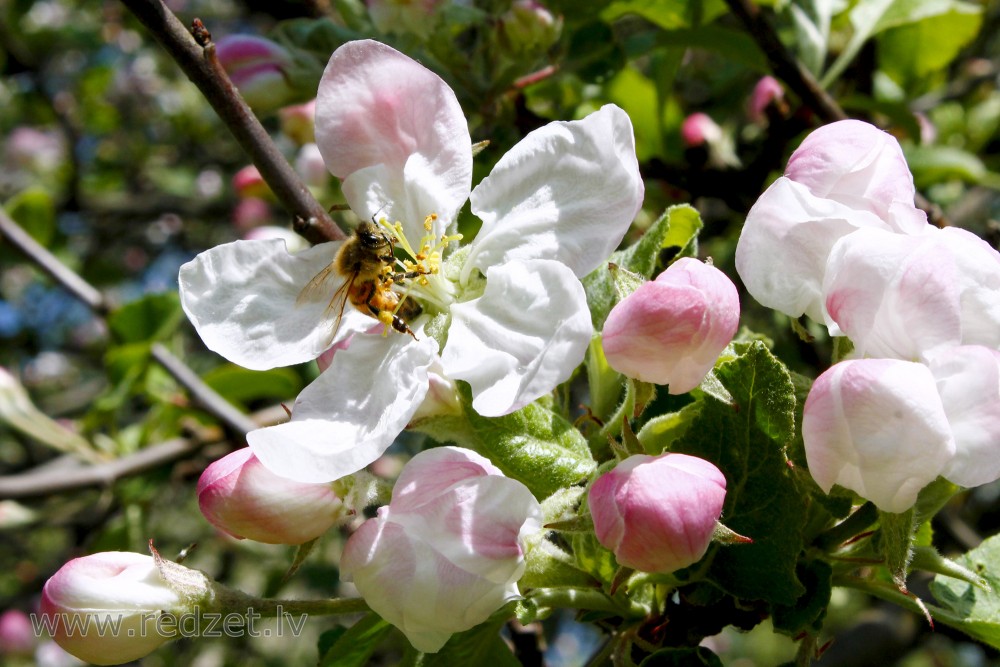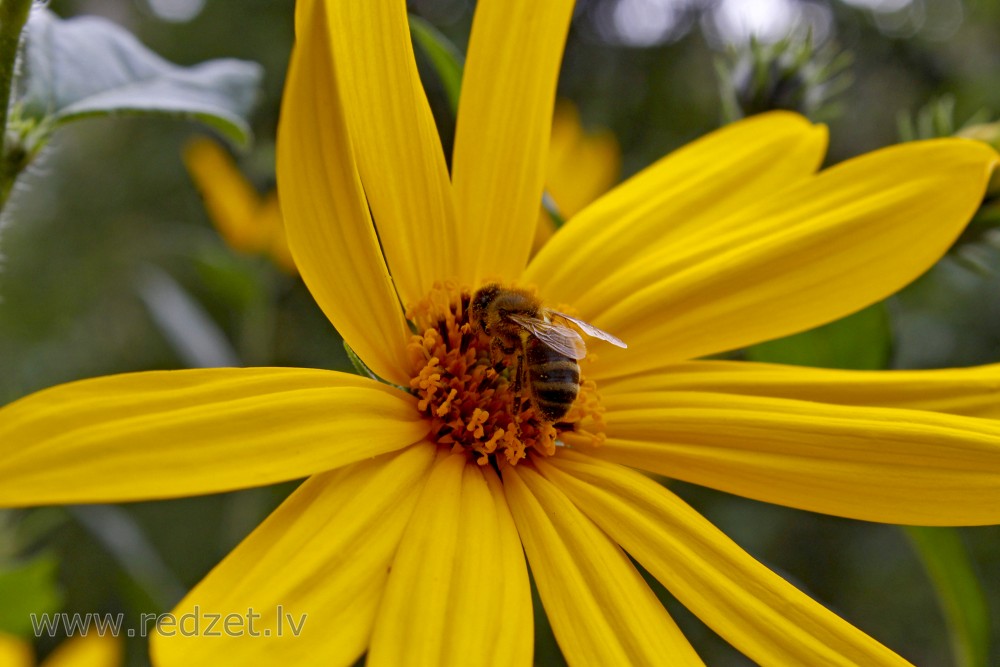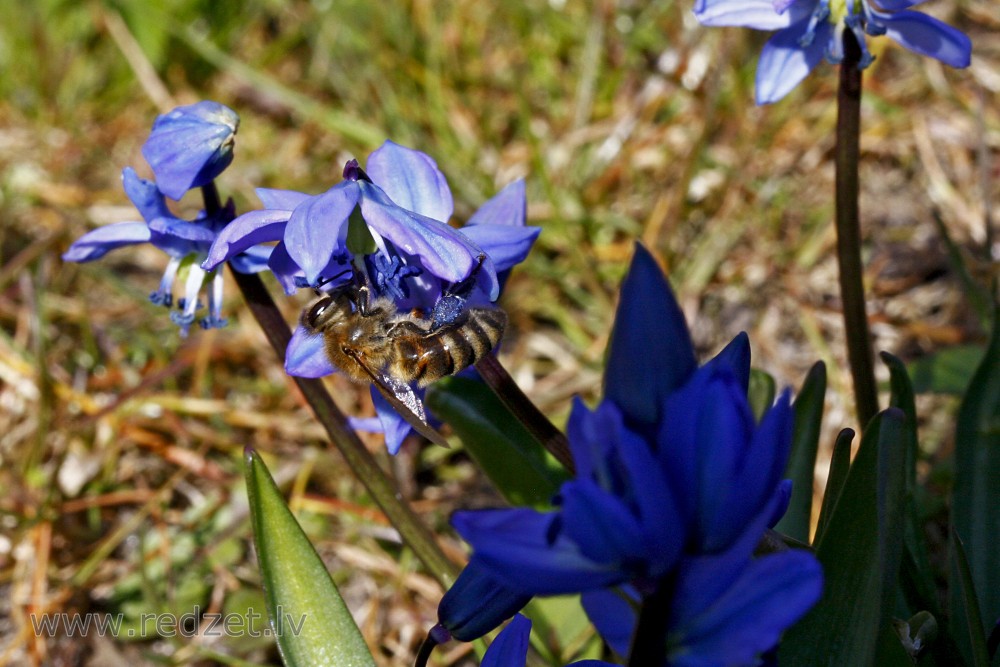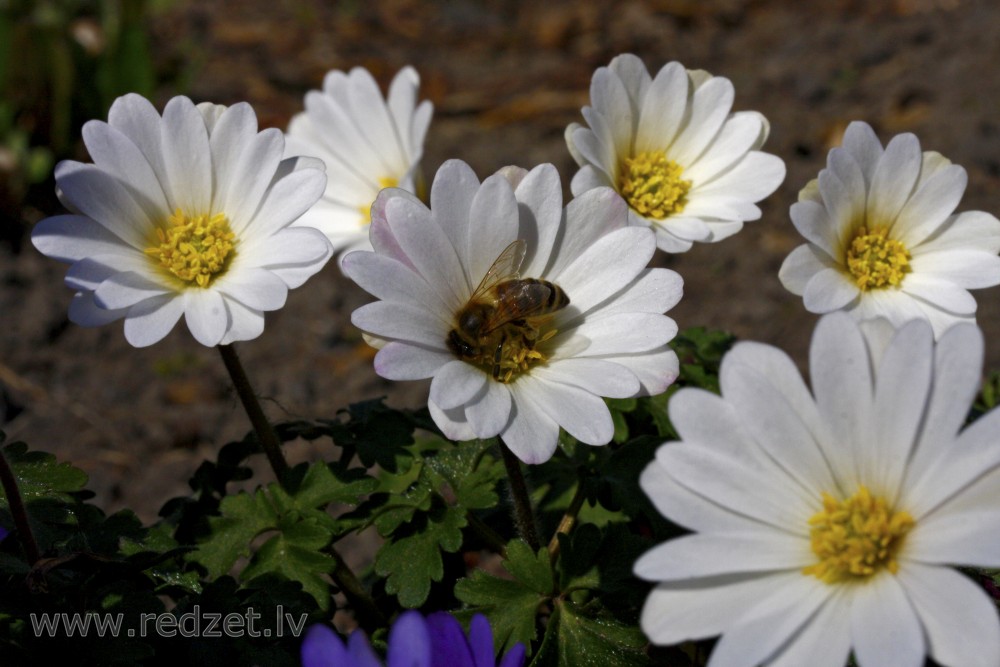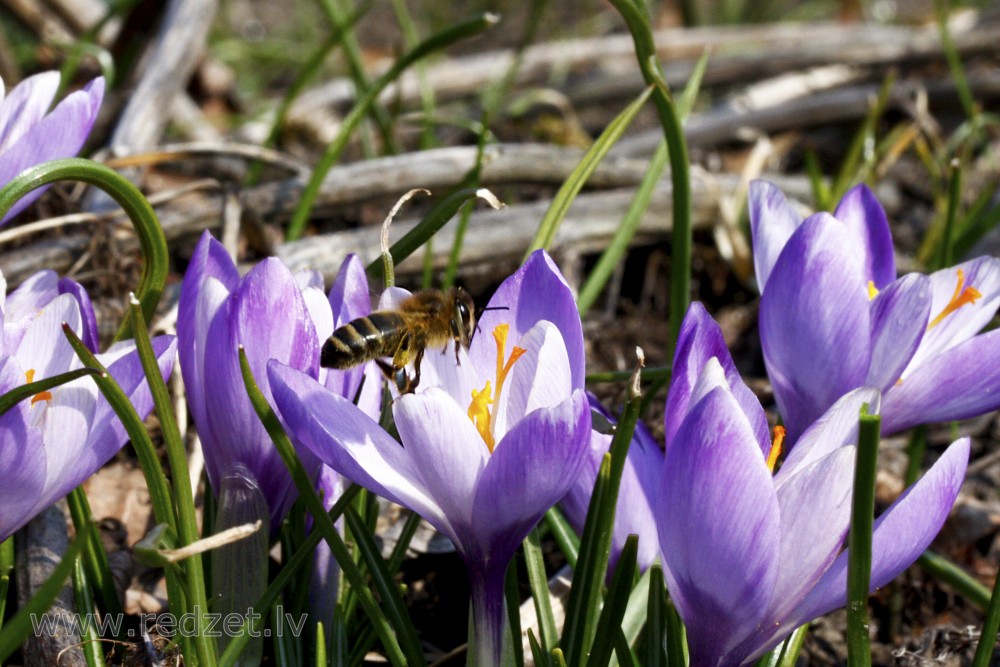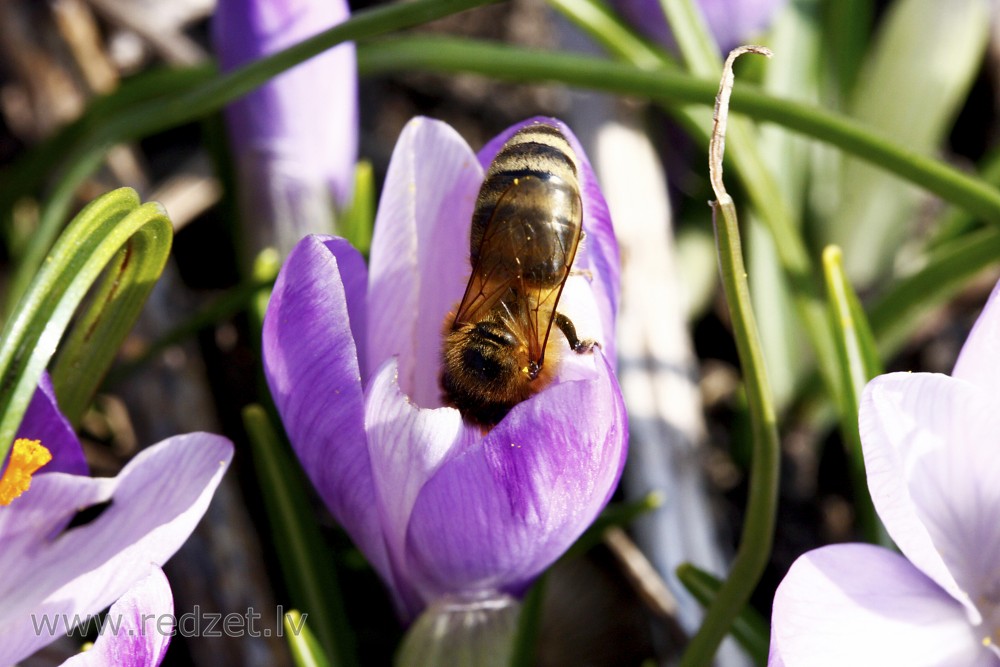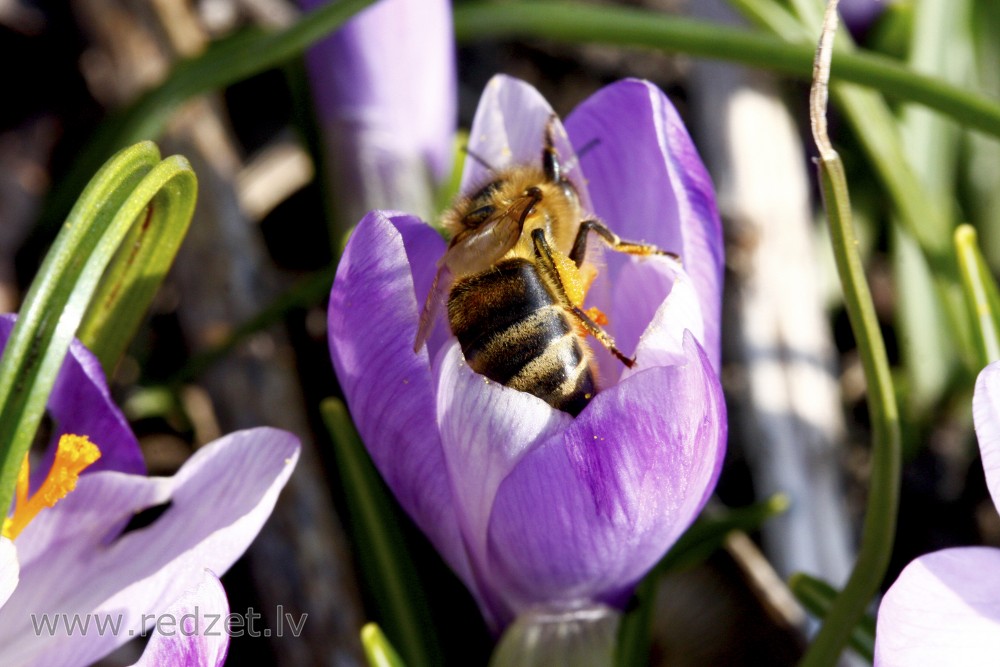Honey bee (Apis)
A honey bee (or honeybee) is any member of the genus Apis, primarily distinguished by the production and storage of honey and the construction of perennial, colonial nests from wax. In the early 21st century, only seven species of honey bee are recognized, with a total of 44 subspecies, though historically seven to eleven species are recognized. The best known honey bee is the Western honey bee which has been domesticated for honey production and crop pollination. Honey bees represent only a small fraction of the roughly 20,000 known species of bees. Some other types of related bees produce and store honey and have been kept by humans for that purpose, including the stingless honey bees, but only members of the genus Apis are true honey bees. The study of bees, which includes the study of honey bees, is known as melittology.
| Honey bees | |
| Kingdom: | Animalia |
| Clade: | Euarthropoda |
| Class: | Insecta |
| Order: | Hymenoptera |
| Family: | Apidae |
| Subfamily: | Apinae |
| Tribe: | Apini (Latreille, 1802) |
| Genus: | Apis (Linnaeus, 1758) |
Origin, systematics and distribution
Honey bees appear to have their center of origin in South and Southeast Asia (including the Philippines), as all the extant species except Apis mellifera are native to that region. Notably, living representatives of the earliest lineages to diverge (Apis florea and Apis andreniformis) have their center of origin there.
The first Apis bees appear in the fossil record at the Eocene-Oligocene boundary (34 mya), in European deposits. The origin of these prehistoric honey bees does not necessarily indicate Europe as the place of origin of the genus, only that the bees were present in Europe by that time. Few fossil deposits are known from South Asia, the suspected region of honey bee origin, and fewer still have been thoroughly studied.
No Apis species existed in the New World during human times before the introduction of A. mellifera by Europeans. Only one fossil species is documented from the New World, Apis nearctica, known from a single 14 million-year-old specimen from Nevada.
The close relatives of modern honey bees – e.g. bumblebees and stingless bees – are also social to some degree, and social behavior seems a plesiomorphic trait that predates the origin of the genus. Among the extant members of Apis, the more basal species make single, exposed combs, while the more recently evolved species nest in cavities and have multiple combs, which has greatly facilitated their domestication.
Most species have historically been cultured or at least exploited for honey and beeswax by humans indigenous to their native ranges. Only two species have been truly domesticated: Apis mellifera and Apis cerana indica. A. mellifera has been cultivated at least since the time of the building of the Egyptian pyramids, and only that species has been moved extensively beyond its native range.
Honey bees are the only extant members of the tribe Apini. Today's honey bees constitute three clades: Micrapis (dwarf honey bees), Megapis (giant honey bee), and Apis (domestic honey bees and close relatives).
Genetics
The genome of Apis has been mapped.
The chromosome counts of female bees for the three clades are:
Clade 2 N
Micrapis 16
Megapis 16
Apis 32
Drones (males) are produced from unfertilized eggs, so they represent only the DNA of the queen that laid the eggs, i.e. have only a mother. Drones of all bee genera have 1 N chromosome counts – half of those shown above.
Workers and queens (both female) result from fertilized eggs, so have both a mother and a father. Arrhenotokous parthenogenesis, a modified form of parthenogenesis, controls sex differentiation. The sex allele is polymorphic, and so long as two different variants are present, a female bee results. If both sex alleles are identical, diploid drones are produced. Honey bees detect and destroy diploid drones after the eggs hatch.
Queens typically mate with multiple drones on more than one mating flight. Once mated, they lay eggs and fertilize them as needed from sperm stored in the spermatheca. Since the number of sex alleles is limited at a regional level, a queen will most likely mate with one or more drones having sex alleles identical with one of the sex alleles in the queen. The queen, then, typically produces a percentage of diploid drone eggs.
Micrapis
Apis florea and Apis andreniformis are small honey bees of southern and southeastern Asia. They make very small, exposed nests in trees and shrubs. Their stings are often incapable of penetrating human skin, so the hive and swarms can be handled with minimal protection. They occur largely sympatrically, though they are very distinct evolutionarily and are probably the result of allopatric speciation, their distribution later converging.
Given that A. florea is more widely distributed and A. andreniformis is considerably more aggressive, honey is, if at all, usually harvested from the former only. They are the most ancient extant lineage of honey bees, maybe diverging in the Bartonian (some 40 million years ago or slightly later) from the other lineages, but do not seem to have diverged from each other a long time before the Neogene. Apis florea have smaller wing spans than its sister species. Apis florea are also completely yellow with the exception of the scutellum of workers, which is black.
Megapis
One species is recognized in the subgenus Megapis. It usually builds single or a few exposed combs on high tree limbs, on cliffs, and sometimes on buildings. They can be very fierce. Periodically robbed of their honey by human "honey hunters", colonies are easily capable of stinging a human being to death if provoked.
- Apis dorsata, the giant honey bee, is native and widespread across most of South and Southeast Asia.
- A. d. binghami, the Indonesian giant honey bee, is classified as the Indonesian subspecies of the giant honey bee or a distinct species; in the latter case, A. d. breviligula and / or other lineages would probably also have to be considered species.
- A. d. laboriosa, the Himalayan giant honey bee, was initially described as a distinct species. Later, it was included in A. dorsata as a subspecies based on the biological species concept, though authors applying a genetic species concept have suggested it should be considered a separate species. Essentially restricted to the Himalayas, it differs little from the giant honey bee in appearance, but has extensive behavioral adaptations that enable it to nest in the open at high altitudes despite low ambient temperatures. It is the largest living honey bee.
Apis
Eastern Apis species include three or four species, including A. koschevnikovi and A. cerana. The genetics of the western honey bee A. mellifera are unclear. The domesticated species are A. cerana indica and A. mellifera
Borneo honey bee
The reddish Koschevnikov's bee (Apis koschevnikovi) from Borneo is clearly a distinct species; it probably derives from the first colonization of the island by cave-nesting honey bees.
Eastern honey bee
Apis cerana, the eastern honey bee proper, is the traditional honey bee of southern and eastern Asia. It was domesticated as subspecies A. c. indica and kept in hives in a fashion similar to A. mellifera, though on a more limited, regional scale.
It has not been possible yet to resolve its relationship to the Bornean A. c. nuluensis and Apis nigrocincta from the Philippines to satisfaction; the most recent hypothesis is that these are indeed distinct species, but that A. cerana is still paraphyletic, consisting of several separate species.
Western honey bee
A. mellifera, the most common domesticated species, was the third insect to have its genome mapped. It seems to have originated in eastern tropical Africa and spread from there to Northern Europe and eastwards into Asia to the Tien Shan range. It is variously called the European, western, or common honey bee in different parts of the world. Many subspecies have adapted to the local geographic and climatic environments; in addition, hybrid strains, such as the Buckfast bee, have been bred. Behavior, color, and anatomy can be quite different from one subspecies or even strain to another.
A. mellifera phylogeny is the most enigmatic of all honey bee species. It seems to have diverged from its eastern relatives only during the Late Miocene. This would fit the hypothesis that the ancestral stock of cave-nesting honey bees was separated into the western group of East Africa and the eastern group of tropical Asia by desertification in the Middle East and adjacent regions, which caused declines of food plants and trees that provided nest sites, eventually causing gene flow to cease.
The diversity of A. mellifera subspecies is probably the product of a largely Early Pleistocene radiation aided by climate and habitat changes during the last ice age. That the western honey bee has been intensively managed by humans for many millennia – including hybridization and introductions – has apparently increased the speed of its evolution and confounded the DNA sequence data to a point where little of substance can be said about the exact relationships of many A. mellifera subspecies.
Apis mellifera is not native to the Americas, so was not present upon the arrival of the European explorers and colonists. However, other native bee species were kept and traded by indigenous peoples. In 1622, European colonists brought the dark bee (A. m. mellifera) to the Americas, followed later by Italian bees (A. m. ligustica) and others. Many of the crops that depend on honey bees for pollination have also been imported since colonial times. Escaped swarms (known as "wild" bees, but actually feral) spread rapidly as far as the Great Plains, usually preceding the colonists. Honey bees did not naturally cross the Rocky Mountains; they were transported by the Mormon pioneers to Utah in the late 1840s, and by ship to California in the early 1850s.
Africanized bee
Africanized bees (known colloquially as "killer bees") are hybrids between European stock and one of the African subspecies A. m. scutellata; they are often more aggressive than European bees and do not create as much of a honey surplus, but are more resistant to disease and are better foragers.[citation needed] Originating by accident in Brazil, they have spread to North America and constitute a pest in some regions. However, these strains do not overwinter well, so are not often found in the colder, more northern parts of North America. The original breeding experiment for which the African bees were brought to Brazil in the first place has continued (though not as intended). Novel hybrid strains of domestic and redomesticated Africanized bees combine high resilience to tropical conditions and good yields. They are popular among beekeepers in Brazil.
en.wikipedia.org
